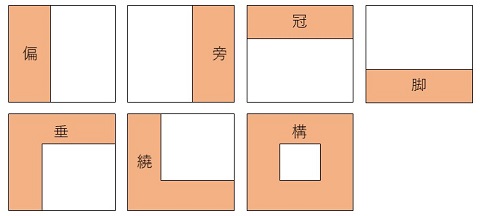About radicals of Kanji
Ladies and gentlemen, here, Leciel explains radicals of Kanji, Bow-Wow.
A radical is a component of Kanji, Ruff-Ruff.
It is classified into 7 types according to the location of the elements in Kanji : 偏(Hen), 旁(Tsukuri), 冠(Kanmuri), 脚(Ashi), 繞(Nyo), 垂(Tare) and構(Kamae).
偏 → Kihen(校、机 etc), Sanzui(海、池 etc)...
旁 → Ozato(都、部 etc), Ogai(顔、頭 etc)...
冠 → Ukanmuri(安、家 etc), Kusakanmuri(花、草 etc)...
繞 → Shinnyo(近、遠 etc), Sonyou(起、越 etc)...
脚 → Rekka(点、然 etc), Hitoashi(兄、元 etc)...
垂 → Gandare(原、厚 etc), madare(広、店 etc)...
構 → Mongamae(間、開 etc), Kunigamae(国、園 etc)...
Today, it is said that there are 214 kinds of radicals, and every Kanji has one radical.
When you classify Kanji by radical, you will be in trouble if it is not classified into one of them, right?
Kanji always have one radical, but when they have multiple components, the most representative one becomes the radical of the Kanji, Bow-Wow.
For example, the radical of Kanji for 酒"Sake" is not "Sanzul" on the left, but "酉" on the right.
Since 酒"Sake" is water, "Sanzui" seems to be the radical, but the character on the right side "酉" originally means a serving cup for 酒"Sake", and "酉" on the right side represents the meaning of Kanji, so it becomes a radical, Ruff-Ruff.
Another difficult example is the Kanji for "聞", this radical is not "Mongamae" but "Mimi".
Like the previous example of 酒"Sake", the most representative element of the meaning of Kanji is radical.
Hmm, the radical is so difficult, Bow-Wow!